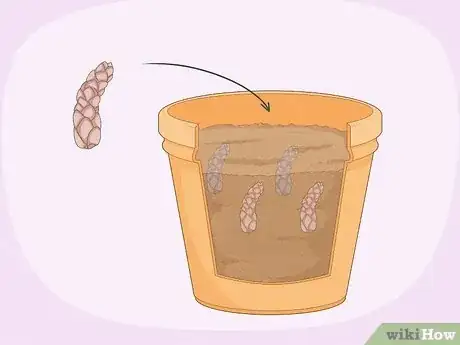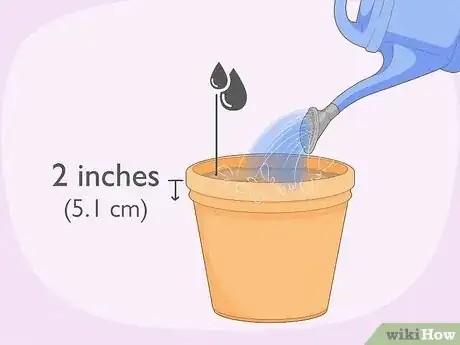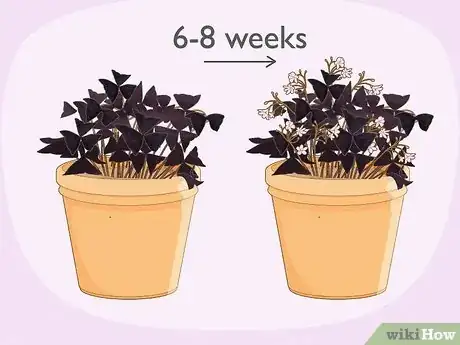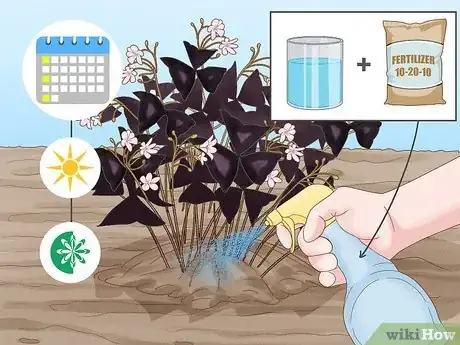This article was co-authored by Lauren Kurtz. Lauren Kurtz is a Naturalist and Horticultural Specialist. Lauren has worked for Aurora, Colorado managing the Water-Wise Garden at Aurora Municipal Center for the Water Conservation Department. She earned a BA in Environmental and Sustainability Studies from Western Michigan University in 2014.
There are 7 references cited in this article, which can be found at the bottom of the page.
This article has been viewed 32,774 times.
Oxalis is an easy and fun plant that you can grow in a pot or a garden. These plants have a variety of different species, some of which have beautiful colored flowers and leaves that resemble shamrocks. While some Oxalis are considered a nuisance, other species, like the false shamrock and pink sorrel variations, make for a beautiful indoor or outdoor plant. If you follow the proper planting methods and care for your Oxalis correctly, they can thrive in a pot or your garden.[1]
Steps
Planting Oxalis in a Pot
-
1Fill a 10-inch (25.4 cm) diameter pot with soil. Purchase a pot or container with drainage holes. Oxalis thrives in well-drained soil like loam or peat moss, but is resilient and will grow in almost any potting medium. Fill the pot about ¾ of the way with the soil.[2]
- You can purchase potting soil at a hardware store, gardening store, or online.
-
2Dig a hole large enough for the root ball or bulb. Use a small spade to dig a hole deep enough to fit the bulb (2 inches (5.1 cm)) or the root ball.[3]Advertisement
-
3Place the bulb or plant in the hole and cover it up. You can get an Oxalis plant by digging up an existing Oxalis plant and dividing it. Alternatively, you can plant a bulb from an Oxalis plant. Both plants and bulbs are also available at gardening centers and online.[4]
- Oxalis plants usually look good grouped together, so if you’re using a larger container, like an 18-24-inch (45.72-60.96 cm) diameter pot, use more than 1 bulb or plant.
- You can plant up to 10 bulbs in a single container.
- Oxalis will grow regardless of the bulb's position.
-
4Water the soil. Water the soil above the bulb or plant, saturating it well. Wait for the soil to dry out before watering the soil again. The top 2 inches (5.1 cm) of the soil should be moist after every watering. You can test this by pressing your finger into the soil and making sure the top 2 inches (5.1 cm) are moist.
- Oxalis should never sit in standing water.
-
5Place the pot in a sunny area. While Oxalis will survive in the shade, they thrive in the sun. Place the pot or container in a well-lit area that gets plenty of sunlight.
-
6Wait 6-8 weeks for the plant to bloom. In 6-8 weeks the Oxalis should bloom. Some species of the plant, like the wood sorrel, will have flowers that open up during the day and close during the night.
Planting Oxalis Outdoors
-
1Plant Oxalis in the spring. Most Oxalis species will bloom sometime in the summer. If you plant your Oxalis in the spring, this will line up with their regular blooming schedule.[5]
-
2Choose a location that has good drainage. If you notice that water pools in an area of your garden, it’s not a good place to plant the Oxalis. These plants require well-drained soil. Go outside after a heavy rain and find locations in your garden where the water does not pool.
-
3Choose a sunny location. Most Oxalis species thrive in heavy sun. However, because of the diversity in the species, Oxalis can grow in a variety of different climates, in zones 6-11.[6] Consider the exposure to the sun when selecting your Oxalis growing location.
- Plant hardiness zones designate the lowest temperatures in any given region in the world. Zones 6-11 range from −10 °F (−23 °C) to over 40 °F (4 °C).
- The false or purple shamrock doesn’t require as much sun and thrives in shaded areas.[7]
-
4Dig holes to fit the root ball or bulb. Oxalis look better in groups so it's a good idea to plant multiple bulbs or plants in your garden. When planting multiple Oxalis bulbs or plants, make sure to space them 3–4 inches (7.6–10.2 cm) apart. Continue to dig small holes until you have enough to house all of your Oxalis bulbs or plants.
-
5Put the Oxalis bulbs or plants into the holes. You can purchase bulbs or plants online or at a gardening store. Place the bulbs any side up into the hole and cover them with the surrounding soil. Alternatively, place the root ball of the plant into the hole and cover it with soil.
-
6Wait 6-8 weeks for the Oxalis to bloom. Oxalis flowers and leaves should open up during the blooming season. Continue to regularly care for your plants by watering them and feeding them with fertilizer until the blooming period is over.[8]
Caring for Oxalis
-
1Water the plant every 2-3 days. Regularly water your Oxalis plant so that the first 2 inches (5.1 cm) of surface soil is moist. If your Oxalis are outside and you get very little rainfall in your area, you may have to water them every day. However, it’s important not to overwater the plants or leave them in standing water.
-
2Fertilize the plant with diluted liquid fertilizer every two weeks. Oxalis are resilient plants and don’t require a lot of fertilizer or special attention. However, if you want to promote flowering and growth, you can apply a balanced liquid fertilizer, diluted in half, every 2 weeks during the spring and summer.
- You can purchase liquid fertilizer online or at a home and gardening store.
-
3Prune dead foliage from the tree late in the summer. At some point late in the summer your Oxalis flowers and leaves will stop opening and the plant will look like it’s dying. This is known as the plant's dormancy period. When this occurs, stop watering the plant and allow the leaves to turn brown. Once the foliage has browned, you can prune it off.[9]
-
4Resume regular watering and fertilizing once the plant blooms. Once you see the plant start to regrow, resume the normal watering and fertilizing schedule.
-
5Keep the plants away from pets or children. Oxalis leaves are poisonous in high quantities. Keep the plant away from pets or small children so that they don’t get sick from eating the plant.[10]
Community Q&A
-
QuestionI have a very healthy oxalis plant that I've just re-potted. While digging up the tubers, I found a few that were not like the others. They were dark and smooth with roots, and firm. What were they?
 HarveyCommunity AnswerThe tubers you may be referring to as dark and smooth may be the bulbs and bulbils of the plant, small divisional portions the plant grows to reproduce itself asexually, akin to onions and lily bulbs. The actual tubers of an oxalis generally appear like small, ovoid, and elongated 'roots' with many eyes (i.e., the little lined indents) along it.
HarveyCommunity AnswerThe tubers you may be referring to as dark and smooth may be the bulbs and bulbils of the plant, small divisional portions the plant grows to reproduce itself asexually, akin to onions and lily bulbs. The actual tubers of an oxalis generally appear like small, ovoid, and elongated 'roots' with many eyes (i.e., the little lined indents) along it.
Things You’ll Need
- Pot
- Oxalis bulbs or plants
- Well-drained soil
- Water
- Fertilizer
- Pruning shears
Warnings
- Beware of signs of Oxalis poisoning; Includes vomiting, diarrhea, lethargy, and weakness.⧼thumbs_response⧽
References
- ↑ https://www.rhs.org.uk/advice/profile?PID=498
- ↑ https://www.easytogrowbulbs.com/pages/oxalis-planting-guide
- ↑ http://www.milmont.com/_ccLib/attachments/pages/PDF-215.pdf
- ↑ http://www.milmont.com/_ccLib/attachments/pages/PDF-215.pdf
- ↑ https://www.rhs.org.uk/advice/profile?PID=498
- ↑ http://www.bhg.com/gardening/plant-dictionary/bulb/oxalis/
- ↑ https://www.houseplantsexpert.com/false-shamrock-plant.html
- ↑ http://www.thegardenhelper.com/bulbousplants.html
- ↑ https://www.houseplantsexpert.com/false-shamrock-plant.html













































































